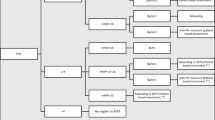Abstract
The aim of this study was to determine the optimal timing of pulmonary artery band (PAB) placement in neonates with single ventricle physiology, unrestricted pulmonary blood flow, and no systemic outflow tract obstruction. Retrospective chart review of all patients who underwent isolated PAB for single ventricle physiology between January 2005 and December 2014 was carried out. The influence of age at the time of PAB on operative mortality, the need for reoperation to adjust the PAB, the preparedness of the pulmonary vascular bed prior to the second-stage bidirectional cavopulmonary shunt (BCPS), and the outcomes following BCPS were studied. The study cohort included 54 subjects (34 males). The median age at the time of PAB was 18 days. The overall mortality following PAB was 4 % (2/54). Reoperation for PAB adjustment was 7 % (4/54). Younger age at the time of PAB was not associated with mortality or increased risk of reoperation. There was a mild positive correlation between the age at PAB and the mean pulmonary artery pressure prior to BCPS. There was also a weak positive correlation between the age at PAB and the duration of ventilation following BCPS. Age at the time of PAB did not influence pulmonary vascular resistance (PVR) prior to BCPS or the mortality and hospital stay following BCPS. PAB can be done safely and effectively soon after birth in neonates with single ventricle physiology, increased pulmonary blood flow, and no potential or actual systemic outflow tract obstruction. It may not be necessary to wait for a few weeks after birth for the neonatal PVR to fall before placing a PAB.
Similar content being viewed by others
References
Alsoufi B, Schlosser B, Mori M, McCracken C, Slesnick T, Kogon B, Petit C, Sachdeva R, Kanter K (2015) Influence of morphology and initial surgical strategy on survival of infants with tricuspid atresia. Ann Thorac Surg. doi:10.1016/j.athoracsur.2015.05.037
Dehaki MG, Tabaee AS, Ahmadabadi CA, Ghavidel AA, Omra G (2012) Pulmonary artery banding in the current era: is it still useful? Ann Pediatr Cardiol 5(1):36–39
Horowitz MD, Culpepper WS 3rd, Williams LC 3rd, Sundgaard-Riise K, Ochsner JL (1989) Pulmonary artery banding: analysis of a 25-year experience. Ann Thorac Surg 48(3):444–450
Jone PN, Schowengerdt KO Jr (2009) Prenatal diagnosis of congenital heart disease. Pediatr Clin N Am 56(3):709–715
Kouchoukos NT, Blackstone EH, Hanley FL, Kirklin JK (2013) Tricuspid atresia and single-ventricle physiology. In: Kirklin JK, Barratt-Boyes BG (eds) Cardiac surgery: morphology, diagnostic criteria, natural history, techniques, results, and indications. Saunders, Philadelphia, PA, p 1525
LeBlanc JG, Ashmore PG, Pineda E, Sandor GG, Patterson MW, Tipple M (1987) Pulmonary artery banding: results and current indications in pediatric cardiac surgery. Ann Thorac Surg 44(6):628–632
Mahle WT, Newburger JW, Matherne GP, Smith FC, Hoke TR, Koppel R, Gidding SS, Beekman RH 3rd, Grosse SD (2009) American Heart Association Congenital Heart Defects Committee of the Council on Cardiovascular Disease in the Young, Council on Cardiovascular Nursing, and Interdisciplinary Council on Quality of Care and Outcomes Research; American Academy of Pediatrics Section on Cardiology and Cardiac Surgery, and Committee on Fetus and Newborn. Role of pulse oximetry in examining newborns for congenital heart disease: a scientific statement from the American Heart Association and American Academy of Pediatrics. Circulation 120(5):447–458
Sasikumar N, Ramanan S, Rema KM, Subramanyan R, Kumar RS, Cherian KM (2013) Pulmonary artery banding for univentricular heart beyond the neonatal period. Asian Cardiovasc Thorac Ann 22(6):660–666
Author information
Authors and Affiliations
Corresponding authors
Ethics declarations
Conflict of interest
The authors have no conflicts of interest to disclose.
Rights and permissions
About this article
Cite this article
Ramakrishnan, K., Alfares, F.A., Hammond-Jack, K. et al. Optimal Timing of Pulmonary Banding for Newborns with Single Ventricle Physiology and Unrestricted Pulmonary Blood Flow. Pediatr Cardiol 37, 606–609 (2016). https://doi.org/10.1007/s00246-015-1321-3
Received:
Accepted:
Published:
Issue Date:
DOI: https://doi.org/10.1007/s00246-015-1321-3




